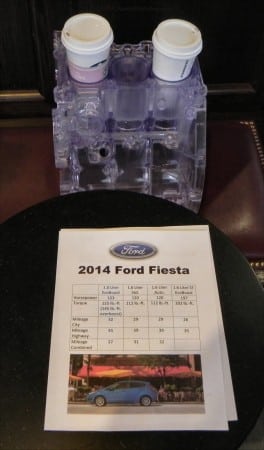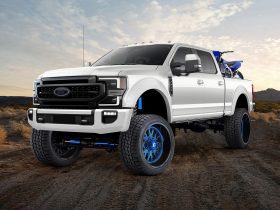Ford held a special press event for automotive media in the Denver, Colorado area and CarNewsCafe attended. The event was to showcase their new 1.0-liter EcoBoost engine, which will be featured in the 2014 Ford Fiesta later this year.
 The engine is a marvel of downsizing and high-compression engineering. It displaces only one liter (the average soda, except in New York where they’re illegal) and yet produces 123 horsepower and 145 lb-ft of torque. To compare that, the currently-available Fiesta with a 1.6-liter engine produces 120 horsepower and 112 lb-ft of torque.
The engine is a marvel of downsizing and high-compression engineering. It displaces only one liter (the average soda, except in New York where they’re illegal) and yet produces 123 horsepower and 145 lb-ft of torque. To compare that, the currently-available Fiesta with a 1.6-liter engine produces 120 horsepower and 112 lb-ft of torque.
To further equate that to numbers that most of us in the real world will understand, the new 1.0L EcoBoost will give the Ford Fiesta 45 mpg on the highway and 37 mpg combined, as compared to the 1.6L mentioned, which receives 39 mpg on the highway and 31 mpg combined. All with slightly better performance to go with those much better fuel economy numbers. And without adding any electric drive components or adding complexity to the cost of the vehicle.
In fact, not only will those numbers make this 1.0L EcoBoost-equipped Fiesta the most fuel-efficient non-hybrid in its class, it will also make it more fuel-efficient than the 2014 Volkswagen Golf TDI (diesel) and the 2014 Honda Insight (hybrid).
Those are numbers that aren’t easy to ignore. So how does the EcoBoost system make this happen?
In a nutshell, EcoBoost is a high-compression gasoline engine block. By increasing the pressure used in the cylinders, fuel burns faster and more efficiently, producing lower emissions and more power output per liter. Adding in turbocharging, direct injection, variable valve timing (VVT), and advanced control software completes the design.
Ford developed their EcoBoost system alongside Mazda’s SKYACTIV system. The two are very similar in design and function. Ford has taken theirs to the bank, though, putting it into about 80 percent of their vehicle lineup before this year is over. They now have five EcoBoost engines in production, ranging from this little 1.0L up to the 3.5L V6 used in the F-150 EcoBoost.
Over 1,000 of these little 1.0-liter EcoBoost engines a day are being produced at Ford’s factory in Germany for the European market. They’re one of the most popular engine options for the Fiesta there. Introducing it in North America seemed obvious and the engine has won International Engine of the Year twice in a row (2012, 2013).
Although all that we were shown was a plastic mockup of the engine, we’ve known that the smallest of the EcoBoost family was on its way this year and have looked forward to learning more about it.
Now, if only the automakers would combine forces. Imagine a small car like the Fiesta with an EcoBoost 1.0-liter engine mated to Chrysler’s eight-speed transmission equipped with Toyota’s Hybrid Synergy Drive and Mazda’s iELOOP stop-start mild hybrid. Plus a battery and plug-in capability from the General Motors Voltec platform. 80 mpg isn’t so hard to imagine at that point.







